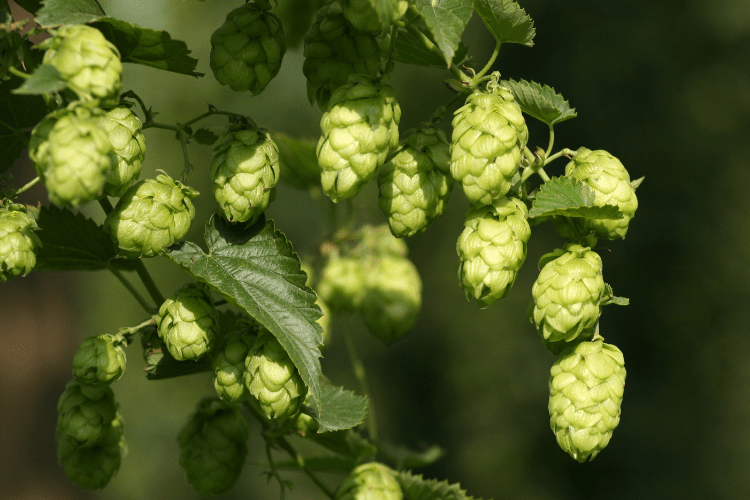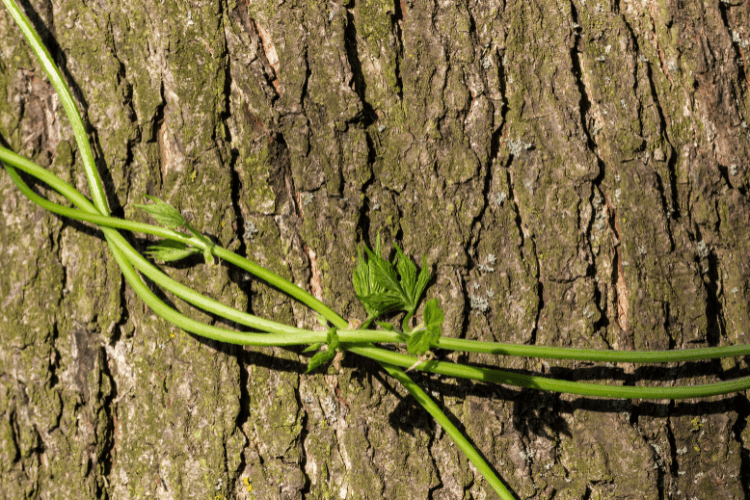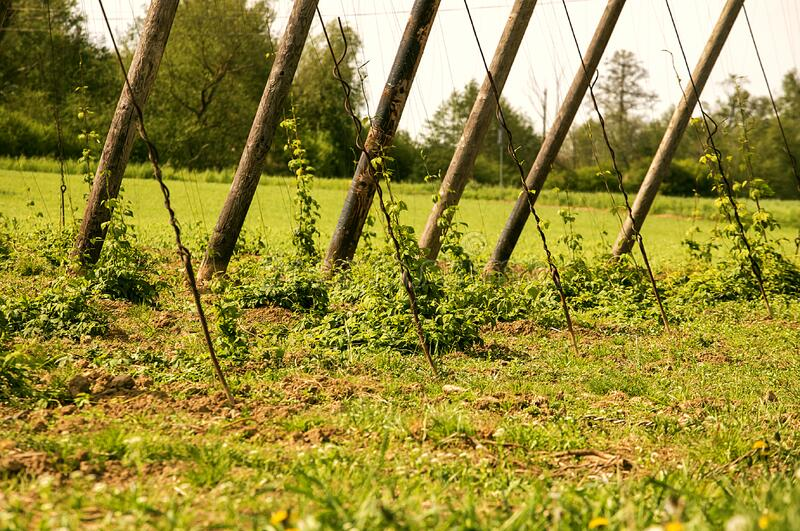- What Is Hop Water: As Simple as it Sounds - October 2, 2022
- What Are Hop Shoots and Are They Worth It - September 10, 2022
The titular question can be one most non-beer experts may have if they’ve never heard of such a thing. If you’ve received word about some part of the famous hop plant that is edible and often compared to asparagus, then congrats! You’re going to learn about the world’s most expensive vegetable.
Let’s say you’re growing your hop flowers or look at a picture of one to see what I’m writing about: do you notice the young purple stem-like pieces growing or the more mature green ones sprouting along with the plant? Well, those right there are what are called hop shoots.
A versatile vegetable that is rare to find in any common market, these things may not make or break a dish but are worth harvesting all the same. If you’re curious about these asparagus want-to-be parts of the popular plant, which I’m assuming you are if you’re reading this now, then let me explain them to you.
Bottom Line Up Front
So, what are hop shoots? In short, hop shoots are the edible ends of the hop plant that can cost you a vast amount if you want to add it to your arsenal of ingredients. Able to be pickled, seared, chopped up, or other cooking methods you can think of, this vegetable can be time-consuming and labor heavy to harvest but can bring a flavorful aspect to your meal or your customers.
If you are a hop plant grower or looking to start, then yes, they are worth the time and effort to pick. However, if you are looking for your next ingredient to try, you may be better off looking elsewhere.
The Hop Plant

Now that you know the basic idea of hop shoots let’s go deeper, starting with the hop plant itself. Hops are flowers (or seed cones) of the plant Humulus Lupulus. A member of the Cannaceae flowering plant family. These plants are widely known in the beer industry as a vital component in most drinks.
They grow like vines upward but are known as “bines” for their different method of latching on to their support system. Small hooks are what do the trick, which is what separates them from the typical vine.
With this plant, the female versions are what you want if you’re looking for what will be helpful to you in the beer-making process. It’s the hops that give beer its bitter, floral taste. With this, they also help maintain freshness and longevity with each batch.
Getting back to the part of the plant at focus, what goes unused in this popular process is the small green stems that do little to help the real hop.
They aren’t a part of the flower itself and aren’t found in your beer. Not the leaves (that can also be eaten) nor the stem of the new plant that goes to waste. These are the hop shoots, as mentioned above. If a new or unknowing grower didn’t know about these things, they might be overlooked and composted with the rest of the plant, but here’s why they are worth your time picking.
The Hop Shoots

Something to note is that there are two types of hop shoots, one being the early blossoming young purple ones you can find straight from the ground.
These are known as bull shoots and can be sturdier and cooked differently than the more common, mature green variants. The latter is the typical hop shoots most growers harvest and sell for practical use. These sprout later in the maturing process and can also vary in sturdiness.
You’ll want to cut off the more rigid ends and keep the softer, bendier aspects for use. Although, there are other ways to utilize the not-so-popular parts: boiling and chopping them up like a garnish is one example. You’ll want the tender pieces the most at the end of the day if you’re going to use them in most dishes.
Now, why bring these small edible parts of the hop plants up? Well, not only are they known as the world’s most expensive vegetable, but they are also talked about whether they are worth fighting for in the first place. I’ll go into more detail about that later. For now, let’s talk more about the rare and pricey vegetable.
Why They’re Important
Something you’ll read about here and elsewhere is that these things are crazy expensive. Yes, having the moniker of the world’s most costly vegetable is saying a lot, but that doesn’t mean you should necessarily skip over these if you want to try them out for yourself. Although I’d recommend looking elsewhere for different flavoring options, here’s why these things are essential.
Cooking and Appearance

One thing about hop shoots is how they can be used for cooking. There’s a reason why they are so commonly talked about as asparagus alternatives. I mean, look at these things. They appear very similar to the more common vegetable or some cilantro-like plant you could put into a dish as a topping.
Not just that, but others have cooked and eaten them all by themselves with some cooking oil along with a cold drink. Whether you go this route, pickle them, grill them to bring a more searing flavor, or any other idea you come up with, there’s plenty you can do with these things.
Flavoring
Described with a rawer flavor uncooked like grass or plain stalks, when cooked, the flavor profiles are better displayed. A “nutty quality to the stems,” according to Alexi Duggins of The Guardian, the leaves apparently “take on a kale-like” flavor palette that brings the attention of these unique ingredients that chefs and others alike could seek out.
And I say chef specifically because most common households won’t necessarily keep hop shoots well stocked in their cabinet for long. Many people may not be able to try these themselves due to their pricing, but with these descriptions, you might be better off using something more practical for your meal.
Why This Part of the Plant?
You may be asking why we choose to eat this part of the plant, not the rest. Other features of the hop plant can be eaten, such as the bittering leaves or the flower itself. While the hop shoots are the most prominent part of this plant to be consumed, the cone and leaves are also edible.
The acid inside the flower gives it that bitter taste, while the essential oils give it naturally different aromas. Though most likely, the hops you’ll come across won’t be fresh, growing your own can give you the best results in any part of the plant to be eaten or cooked.
The leaves are often associated with being used as a garnish topping, such as a substitute for parsley or cilantro. But what sets this portion of the plant apart is its comparison to asparagus and contributes to it being the most sought-after cut of the plant to cook with.
Also, note that if you decide to get any of these, store them in a dark and dry area away from light and heat as they tend to go bad fast. So if you get your hands on some, don’t expect them to last very long either.
What Makes the Plant Itself
So, I briefly talked about the essential oils in these flowers earlier, and I’ll do the same here—but with a bit more info I want to give y’all for fun.
With this plant comes the knowing scent when around. What truly gives the plants their odor is organic compounds called Myrcene, Humulene, and Caryophyllene. That enriching smell you get when taking in these scents come from the combination of these three hydrocarbons.
This information may benefit people who are interested in the more scientific breakdowns of the plant itself. Many sources don’t cite these nor go into detail about what makes these flavors and smells work, but I like to know things, so if you do, you’re welcome. Now with all this information out of the way, let’s regain focus on the topic at hand as we begin to wrap things up—hop shoots.
Hop Shoots and Their Uses

Aside from being used as an asparagus alternative, being creative with them can bring new and innovative methods. I can see myself shredding the leaves into flakes and using them as toppings on many meals, such as enchiladas or pizza. They have the potential to make any dish look fancy to your guests or family.
Just tell them how much you paid for them and see their jaws drop in awe at your crazy good cooking skills and etiquette. With the hop shoots themselves, grilling them is my go-to method, and it is for many others.
Using a skillet and your choice of oil is another excellent way of bringing out their natural flavor. This method can take mere minutes and may be a great way to get a first impression of how they taste cooked.
Pickling is also a popular way of eating them that takes little ingredients and effort. This method can work best for the younger purple shoots that are less tender. Just let them sit for a few days or as needed and enjoy them.
Remember, some of the lower ends can be tougher than the tops of the shoots, so make sure to separate these aspects before cooking to maintain a consistent texture while eating. Think about stemming your asparagus before eating. It’s basically the same process. If the ends are too tough and not enjoyable, they may be better off being disposed of.
This applies to home growers harvesting themselves, as most hop shoots purchased may already have these ends cut before purchase. But again, the price may be the breaking point for many casual customers looking for something new to try.
And speaking about the price of these, let’s come back to that.
Farming and Growing

If you want to start growing your hop shoots, then learning how to grow the actual hop plant is vital. The shoots are just a byproduct of the leading flower, so you’ll need to be prepared to maintain a healthy plant properly.
Many growers start with rhizomes that can usually be purchased at the beginning of every year. Since they typically are harvested around March, the spring season is the ideal time to start growing.
You’ll want to ensure that your chosen location will have access to plenty of sunlight year-round. This is essential for the hops to grow fully and stay in season for years. A general rule of thumb is to space out these rhizomes you’ll be planting three to six feet away from each other, making sure not to overwater them and provide enough soil to retain just enough for them to strive.
As they begin to grow, you’ll notice that they can become very tall, with some reaching up to around twenty feet in length. Because of this, you’ll need to train the bines to grow appropriately by giving your plant support to latch on to. With this, maintaining the growth of the hop plants will become much more manageable.
Harvesting usually occurs in the fall, but the younger the plant is, to a lesser extent. If it is your first year doing so, you can expect a smaller batch to go off, but as the years go on, larger harvests will come as the plants fully take shape and bloom until about the third year. The plants will most likely give you the most they can offer.
The Price
Sources show that they can vary in price, but bundles of 200 can be purchased for $35 each, according to “The Hop Yard.” Because of the labor needed to harvest these little things, the cost will be expectedly high, as stated numerous times now, but if you are determined to try them out, I say go for it.
Since they don’t last long and most of the ones you’ll obtain won’t be fresh, you may be better off harvesting your own. It will take longer to try them, but the cost will be cheaper, they’ll taste their absolute best, and you’ll have some hops and leaves to do as you will!
Are They Worth It?
Alright, here’s why they may not be worth getting in the first place.
Because of how difficult they can be to obtain, the price, their flavoring, and other components, some may suggest that they aren’t worth seeking out. I partially fall under this umbrella as well.
Whether you want to try these things yourself, you may be better off going with regular asparagus or other alternatives that are much easier to obtain. If you are growing hops yourself and are looking for a reason to invest time and effort into harvesting them, that’s a different story.
Although they are difficult to harvest enough to make it worthwhile, it may be an investment. If you choose not to sell or don’t have enough, you can always keep them for yourself to eat or give to friends and family.
Now with all that said, we can go into some frequently asked questions for anyone further needing information.
Frequently Asked Questions
Question: Why are Hop Shoots Expensive?
Answer: Because of their size, the labor it takes to pick and harvest them, and the amount one produces each season, the combination of these factors brings the price up considerably high.
Question: Are there any Health Benefits?
Answer: There are benefits to the hop flowers, helping with anxiety, insomnia, and others when used as a medicine. Still, hop shoots, however, may not carry the same benefits as an ingredient or in a drink.
Question: Where Can I Get Hop Shoots?
Answer: Most standard grocery outlets won’t carry the product regularly, but access can be found through online means with shipping. As they grow from the hop plants, they can also be obtained by self-harvesting or a local grower.
Final Thoughts
To finish off, hop shoots are the hop plant’s green tips that don’t get harvested for making beer. Separate from the flower itself and the leaves, these asparagus-like aspects of the plant are utilized in other ways, such as cooking and blending into meals and side dishes.
No other part of this plant brings this versatility like the shoots, which is why they are sought out. Whether you use them as a side dish, toppings, or straight up a meal all on their own, the hop shoots can bring a tasty alternative to more common vegetables you may find in grocery outlets around you. With a price like this, many people may not see them as worthwhile, and I agree.
If you want to try these things out, by all means, but for a casual individual looking for new ingredients to taste in their next dish experiment, they may not be worth the cost nor the wait time as you may more likely than not need to have a small batch of them shipped to you.
You can create a dish without such a hard-to-get commodity with a flavor that can almost be captured by other means, such as regular asparagus, kale, and a mixture of oils and other items.
Linked Websites:
The Hop Yard – Wholesale Hop Shoots
Work Cited:
“It’s like eating a hedgerow: why do hop shoots cost €1,000 a kilo?” by Duggins, Alexi. The Guardian, 18th, May 2015.\

